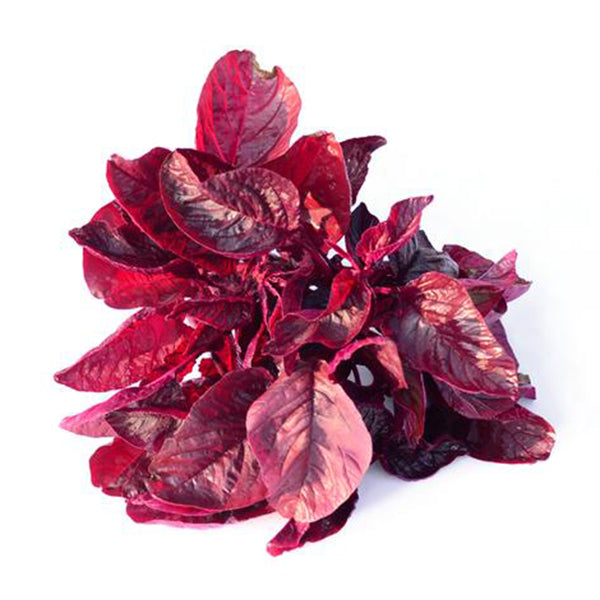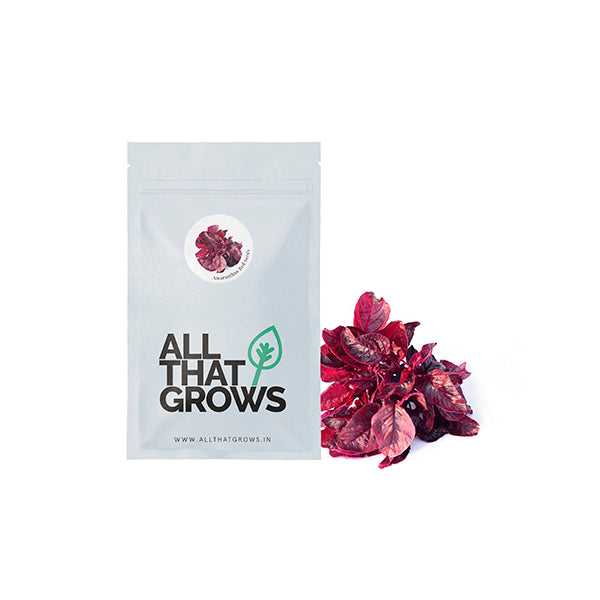



Amaranthus Red Seeds
Grow this with
Seed Type : Non-Hybrid, Open Pollinated and Non-GMO
SOWING TIME : Recommended For Year Round Sowing except Dec-Feb as the plant is susceptible to cold temperatures
PLANT CHARACTER : Preferring warm temperatures, Amaranth has long straight stems with long lasting flowers
LEAF CHARACTER : Medium sized green leaves with Burgundy red overlay
HARVEST: 48-56 days after planting, pick individual leaves and chaff the seeds as needed
- SOWING
TIMEFeb - Mar
Jun - Jul - Sowing
DistanceLine to line - 1.5'
plant to plant - 1' - Fruit
WeightN/A
- Fruit
ShapeBright red-violet leaves
- Days to
maturity30-35 days
- Details
- How to sow
- Reviews
Amaranth or Amaranthus is a tropical and sub-tropical seasonal crop categorized as a leafy vegetable, cereal, and also as an ornamental plant. Resembling spinach in looks and artichoke in taste, the red leaf amaranth is full of nutritional benefits that surpass most of its green leafy counterpart. It is naturally gluten-free and is also a great addition to gluten-free dishes. It also comprises the amazing protein lysine and comes packed with all the other essential amino acids too. Not just this, uncooked red amaranth consists of 82% iron, 31% calcium, and 14% Vitamin C. So eating these pretty looking leaves raw in salads and sandwiches is a health treat all by itself!
The other nutrients and minerals, this vegetable is rich in, includes magnesium, phosphorous, potassium, and dietary fibre. It's intake is very beneficial to the heart, as it lowers bad cholesterol levels. The easy to digest leaves are also known to improve eyesight, prevent excessive hair loss, and premature greying. With so much that the beautiful red leaves can offer, take in as much as you can. Cook it, stir fry, or come up with a completely new way of having this vegetable!
Planting instructions
Gather the seeds and plant in late fall by spreading the seeds along the field.
Amaranthus seeds can be directly seeded into your flower garden, or started indoors for transplanting later.
Space seeds or seedlings 10-12" apart. They will tolerate a little crowding, and look good in clumps or groups.
Amaranth is a warm season crop that requires full sun. Best germination occurs when soil temperatures are warm and grows well by planting in the same spot as leaf lettuce or radishes.
Growing Requirements
watering
Water the plant regularly, with small quantities of water every morning. Amaranth is fairly drought-tolerant.
pests
The plants are vulnerable to Tarnished plant bug and Amaranth weevil. The pests swarm around the growing seed heads and suck the fluid out, they can stunt the seed production. The weevils are a 2-stage threat with the larvae chewing on the roots and the adults going after the leaves.
soil
Amaranthus needs soil with a pH ranging between PH 4.2 to 9.1. It grows well in well- drained soil rich in Nitrogen and Phosperous
spot
Amaranthus prefers warm climate with six to eight hours of full sun
temperature
Amaranth germinates best at soil temperatures around 25 degree celsius (72 degree F)
how to harvest
To determine if it is ready for harvest, keep a sheet of clean paper under the bent over seed head and shake gently. If you see tiny, shiny black seeds falling on the paper,the crop is ready for harvest.
Once the seeds begin to readily fall from the tassels, take the seed heads in your hands and rub them over a bucket to catch the seed. This method of harvesting lessens the amount of debris and chaff that needs to be removed.
Once you have harvested the amaranth, it needs to be completely dried before you store to avoid molding. Leave it on trays to dry in the sun before storing.

Customer Reviews
The productiveness of any seed we sell is subject to your local climatic conditions*, the sowing method you adopt, and your commitment to the planting process. We give no warranty, expressed or implied, and are in no way responsible for the produce.
Please note that all our seasonal recommendations/ sowing information is as per the local climatic conditions. *For more information on the optimum conditions required for growing seeds in your region, please contact us at, hello@allthatgrows.in or Whatsapp us at, +91 8544865077
Questions & Answers
Have a Question?
Be the first to ask a question about this.




Amaranthus Red Seeds
Seed Type : Non-Hybrid, Open Pollinated and Non-GMO
SOWING TIME : Recommended For Year Round Sowing except Dec-Feb as the plant is susceptible to cold temperatures
PLANT CHARACTER : Preferring warm temperatures, Amaranth has long straight stems with long lasting flowers
LEAF CHARACTER : Medium sized green leaves with Burgundy red overlay
HARVEST: 48-56 days after planting, pick individual leaves and chaff the seeds as needed
Grow this with
Amaranth or Amaranthus is a tropical and sub-tropical seasonal crop categorized as a leafy vegetable, cereal, and also as an ornamental plant. Resembling spinach in looks and artichoke in taste, the red leaf amaranth is full of nutritional benefits that surpass most of its green leafy counterpart. It is naturally gluten-free and is also a great addition to gluten-free dishes. It also comprises the amazing protein lysine and comes packed with all the other essential amino acids too. Not just this, uncooked red amaranth consists of 82% iron, 31% calcium, and 14% Vitamin C. So eating these pretty looking leaves raw in salads and sandwiches is a health treat all by itself!
The other nutrients and minerals, this vegetable is rich in, includes magnesium, phosphorous, potassium, and dietary fibre. It's intake is very beneficial to the heart, as it lowers bad cholesterol levels. The easy to digest leaves are also known to improve eyesight, prevent excessive hair loss, and premature greying. With so much that the beautiful red leaves can offer, take in as much as you can. Cook it, stir fry, or come up with a completely new way of having this vegetable!
Seed Type : Non-Hybrid, Open Pollinated and Non-GMO
SOWING TIME : Recommended For Year Round Sowing except Dec-Feb as the plant is susceptible to cold temperatures
PLANT CHARACTER : Preferring warm temperatures, Amaranth has long straight stems with long lasting flowers
LEAF CHARACTER : Medium sized green leaves with Burgundy red overlay
HARVEST: 48-56 days after planting, pick individual leaves and chaff the seeds as needed
- SOWING
TIMEFeb - Mar
Jun - Jul - Sowing
DistanceLine to line - 1.5'
plant to plant - 1' - Fruit
WeightN/A
- Fruit
ShapeBright red-violet leaves
- Days to
maturity30-35 days
Planting instructions
Gather the seeds and plant in late fall by spreading the seeds along the field.
Amaranthus seeds can be directly seeded into your flower garden, or started indoors for transplanting later.
Space seeds or seedlings 10-12" apart. They will tolerate a little crowding, and look good in clumps or groups.
Amaranth is a warm season crop that requires full sun. Best germination occurs when soil temperatures are warm and grows well by planting in the same spot as leaf lettuce or radishes.
Growing Requirements
watering
Water the plant regularly, with small quantities of water every morning. Amaranth is fairly drought-tolerant.
pests
The plants are vulnerable to Tarnished plant bug and Amaranth weevil. The pests swarm around the growing seed heads and suck the fluid out, they can stunt the seed production. The weevils are a 2-stage threat with the larvae chewing on the roots and the adults going after the leaves.
soil
Amaranthus needs soil with a pH ranging between PH 4.2 to 9.1. It grows well in well- drained soil rich in Nitrogen and Phosperous
spot
Amaranthus prefers warm climate with six to eight hours of full sun
temperature
Amaranth germinates best at soil temperatures around 25 degree celsius (72 degree F)
how to harvest
To determine if it is ready for harvest, keep a sheet of clean paper under the bent over seed head and shake gently. If you see tiny, shiny black seeds falling on the paper,the crop is ready for harvest.
Once the seeds begin to readily fall from the tassels, take the seed heads in your hands and rub them over a bucket to catch the seed. This method of harvesting lessens the amount of debris and chaff that needs to be removed.
Once you have harvested the amaranth, it needs to be completely dried before you store to avoid molding. Leave it on trays to dry in the sun before storing.



 Sign In
Sign In








